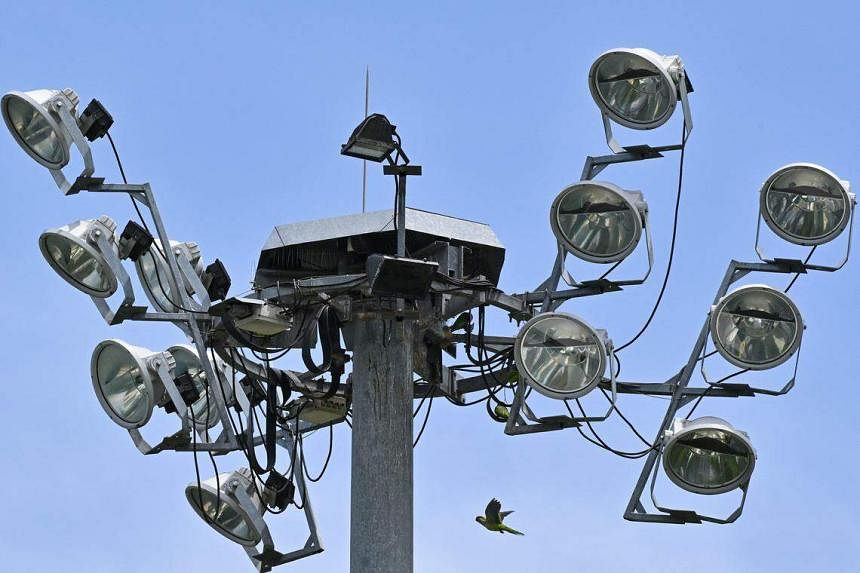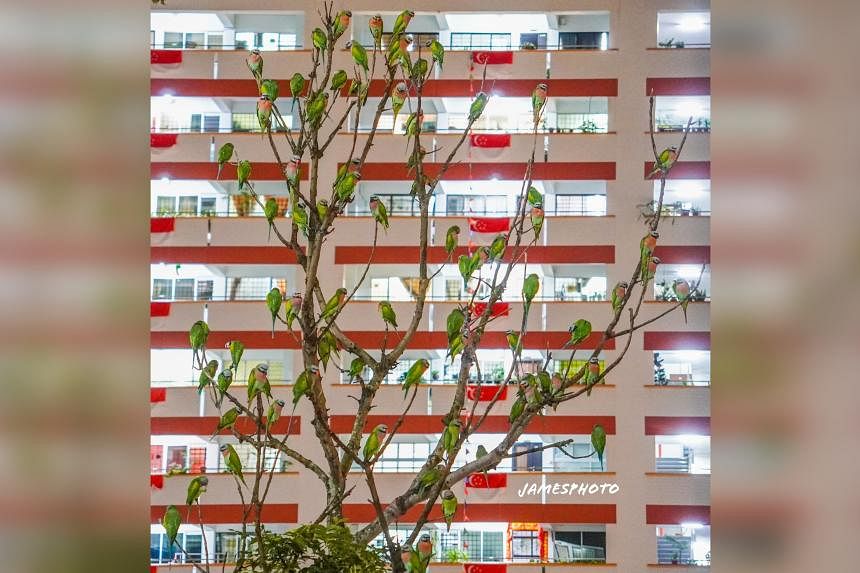SINGAPORE – A recent photograph of a huge flock of parakeets resting on a tree in Choa Chu Kang has renewed attention to the bird situation in the estate.
At first glance, viewers of retiree James Teiw’s picture on Facebook group Singapore Wildlife Sightings may mistake the red-breasted parakeets for leaves on a tree along Choa Chu Kang Avenue 4.
On closer inspection of the photograph, which has drawn nearly 9,000 reactions online since it was uploaded on July 11, the almost-bare tree had over 70 such parakeets perched on its branches.
Early intervention teacher Chiam Zhi Lin, 24, who has lived in the housing estate since she was born, said: “It’s literally Bird Paradise in Choa Chu Kang.”
While these non-native birds are attractive to some and have thrived in numbers around the island, they may disrupt the local eco-system, experts told The Straits Times.
The National Parks Board (NParks) worked with the Chua Chu Kang Town Council to catch and cull non-native birds, including red-breasted parakeets, in the Choa Chu Kang housing estate in November 2022. About 60 per cent of birds caught were put down then.
More than 800 red-breasted parakeets were recorded in Singapore by volunteers in February, up from about 330 in 2012, according to non-profit group Nature Society (Singapore).
Dr Yong Ding Li, who coordinates the society’s annual count of introduced and native parrots in urban areas, said the red-breasted parakeet population in Singapore is estimated to be “several tens of thousands now”, with informal records of the birds spreading to Johor.
In Choa Chu Kang alone, about 700 red-breasted parakeets, which naturally occur in mainland South-east Asia, were counted in 2023. Dr Yong said roosts for the birds have also been spotted at Sembawang, Changi, and Tampines, with more possible locations that have not been surveyed.
Asked why parakeet numbers remain abundant despite the recent culling efforts, Dr Yong said: “It will take a number of years before the effects of culling can be felt as is the case with many cull-based interventions, especially if the species has a large and growing population, regardless of the cull.”
Red-breasted parakeets were introduced here in the 1940s through the pet trade and their population has become self-sustaining with local breeding recorded. To date, they can be found in parks, gardens and scrubland across Singapore.
Ornithologist Movin Nyanasengeran from the Singapore Birds Project, a birding enthusiast group, said the loss of rainforests and proliferation of parks in Singapore have helped the bird to flourish here.
He said: “The red-breasted parakeet is native to regions with very distinct wet and dry seasons, unlike Singapore, and forests that have an open canopy of scattered trees more similar to the parks that dominate our landscapes today.”
Mr Tan Gim Cheong, the chairman of Nature Society (Singapore)’s bird group, said the invasive species is known to compete with native species for resources like food and nesting sites.
He said: “Red-breasted parakeets are aggressive and will compete with bigger birds for tree holes to nest in.
“Each pair lays three to four eggs, so their population can increase quite fast.”
NParks’ group director of wildlife management Ryan Lee said: “They may also indirectly affect native biodiversity through the transmission of exotic diseases and parasites.”
Mr Andrew Tay, co-founder and nature consultant of non-profit Cicada Tree Eco-Place, said: “The issue of exotic introduced species must be taken seriously by the authorities, as they have long been scientifically proven to be detrimental to native biodiversity and habitats, apart from becoming a nuisance to people.”
NParks regularly removes non-native animals from nature reserves and other green spaces, as established non-native species can expand exponentially without human intervention, said Mr Lee.This is unlike populations of native species, which are naturally managed through factors like availability of food and predators.
Responding to queries, the Chua Chu Kang Town Council said in tandem with NParks’ management of the birds, it conducts regular tree pruning to discourage and reduce the roosting parakeets in the estate.
It said: “The sightings of parakeets in the current area may have increased due to the birds’ movement from nearby trees that were recently pruned.”
Bird experts said that measures taken to reduce their population will benefit native birds like the long-tailed parakeet, an endangered species with the “globally vulnerable” status.
Bird enthusiasts said the monk parakeet – another non-native parakeet species – is an emerging problem.
First spotted at the reclaimed Changi Cove in 2009, the birds have recently been sighted at Gardens by the Bay, Sungei Buloh Wetlands Reserve and Ulu Pandan.

Mr Tan said: “They make big communal nests on tall trees or man-made structures like floodlights. Their large nests, if they were to deteriorate and fall, could be a hazard to people below.”
Mr Movin added: “The massive, bulky nests that these parakeets build are known to sometimes disrupt electrical supplies in the United States when the nests they build in electrical substations catch fire and require regular maintenance to mitigate.
“Thankfully, power lines are located underground in Singapore, but there could be potential impacts to other infrastructure that might not be known yet.”

